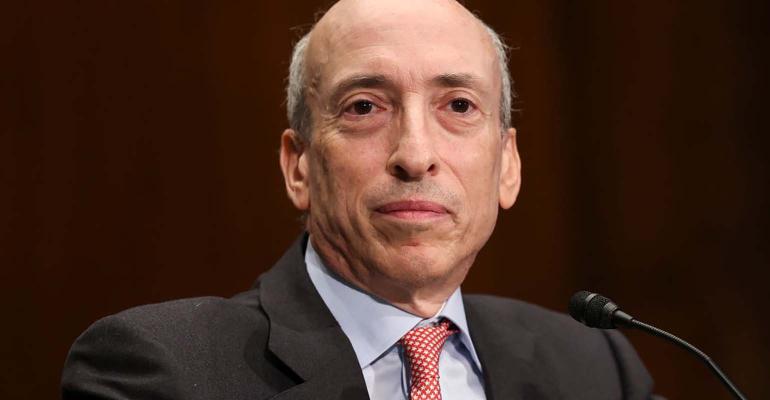(Bloomberg) -- Money-market funds are getting their biggest rules overhaul in years after Wall Street’s top regulator finalized a plan to stem rapid outflows during times of financial stress.
The US Securities and Exchange Commission decided Wednesday to require fees that could significantly affect a key corner the $5.5 trillion industry. Although the regulations will make it more expensive to yank money during tumult, the regulator backed off a “swing pricing” proposal that the industry opposed.
The new rules are meant to discourage runs like the one in March 2020 and shield remaining shareholders from costs tied to the high level of redemptions. After the pandemic’s onset roiled markets, the Federal Reserve was forced to step in to rescue money-market funds for the second time in 12 years, leading to calls for the SEC to impose tougher regulations.
Under the regulations approved by three of the commission’s five members, some funds will face mandatory liquidity fees. Those will kick in after a one-year implementation period for institutional prime and institutional tax-exempt funds when daily redemptions surpass 5% of net assets.
“I believe that liquidity fees, compared with swing pricing, offer many of the same benefits and fewer of the operational burdens,” SEC Chair Gary Gensler said. The changes will make money-market funds more resilient, he added.
Read more: Money-Market Funds Brace for Biggest Regulatory Revamp in Years
The liquidity-fee approach that the SEC decided to impose would require fund managers to charge redeeming investors to discourage a rush to be first to exit the fund during times of market volatility. Mass redemptions can increase costs to a fund and dilute remaining shareholders’ assets.
Swing pricing, essentially a cost imposed on investors redeeming shares in money-market funds, differs in that it would adjust — or swing — the price above or below a fund’s net asset value per share, in the event flows in or out of a fund are determined to be too large.
Industry Reprieve
An SEC proposal in December 2021 would have made the swing-pricing measure mandatory, specifically for institutional prime and institutional tax-exempt money-market funds.
The reprieve marks a significant victory for JPMorgan Chase & Co.’s asset management unit, State Street Corp. and Federated Hermes Inc., which had opposed the measure. Among the complaints were that swing pricing would drive up investor costs and lead to a large decrease in institutional money-market funds’ assets.
Still, the SEC’s decision to back off didn’t satisfy critics.
The shift to a liquidity fee as an alternative to swing pricing isn’t likely to get “a full-throated endorsement” by money-market funds, Republican Commissioner Hester Peirce said during a meeting to consider the plan on Wednesday.
That sentiment was swiftly echoed by some in industry, including Investment Company Institute Chief Executive Officer Eric Pan, who said by email that the SEC “has missed the mark” by forcing some funds to adopt costly and complex fees. ICI is a trade group representing money-market funds.
“There’s an amount of relief that the vote has happened but there’s a new challenge with liquidity fees,” said Jeff Weaver, a senior portfolio manager and head of global liquidity solutions at Allspring Global Investments, which has more than $530 billion assets under management. “We need to wrap our arms around that.”
Time to Comply
Peirce, one of two Republicans on the SEC, also said firms would benefit from additional time to get ready for the changes.
William Birdthistle, who leads the SEC’s investment management division, said that the implementation period was sufficient. Money-market funds can take advantage of their experience with the existing liquidity-fee framework, which is less onerous than swing pricing, he said.
The other point of contention for the industry was forcing government funds to convert to a floating net asset value in the event of a negative interest-rate environment. Under the final rule, these vehicles can choose how to maintain a stable net asset value per share. They can either convert to a floating share price, or reduce the number of shares outstanding.
Some funds will also see their minimum daily and weekly liquid asset requirements rise to 25% and 50%, respectively, from the current levels of 10% and 30%. “This will provide a more substantial buffer in the event of rapid redemptions,” Gensler said.
The SEC said that the industry will have a transition period to comply.
Brokerage Proposal
Separately, the commission proposed requiring large brokerages to calculate the net cash owed to customers and other firms on a daily rather than weekly basis. According to Gensler, the plan would make it less likely that customers lose money if a broker fails.
The SEC says that many big firms already do daily calculations. Unlike the money-market fund rules which are now final, the agency must take public feedback on the brokerage calculation plan and vote again to put it in place.





